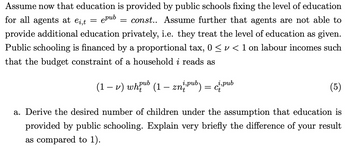In period t, a parental household (indexed by i) equipped with human capital hit earns a labour income of wh^i_t, where w > 0 represents a constant wage rate. This household derives utility out of own consumption c^i_t, the number of children nit and their level of human capital h^i_(t+1). Education is provided by teachers who are equipped with the economy’s average level of human capital h^T_t . Human capital per child evolves from one period to another according to h^i_(t+1) =(e^i_t +e ̄)^η(h^i_t)^τ(h^T_t )^(1−τ), 0 < η, τ < 1 (1) where e ̄ > 0 is a constant parameter and e^i_t represents the level of education per child. The households’ utility function is specified as U_t^i = ln(c^i_t) + γ[ln(n^i_t) + βln(h^i_(t+1))] (2) with γ,β > 0. Raising one child to adulthood requires a share of 0 < z < 1 units of time. Moreover, education is subsidised at a rate 0 ≤ s_e < 1, such that education costs per child amount to wh^T_t e^i_t(1 − s_e). Solve household i’s optimisation problem and explain the economic rationale of your results.
In period t, a parental household (indexed by i) equipped with human capital hit earns a labour income of wh^i_t, where w > 0 represents a constant wage rate. This household derives utility out of own consumption c^i_t, the number of children nit and their level of human capital h^i_(t+1). Education is provided by teachers who are equipped with the economy’s average level of human capital h^T_t . Human capital per child evolves from one period to another according to
h^i_(t+1) =(e^i_t +e ̄)^η(h^i_t)^τ(h^T_t )^(1−τ), 0 < η, τ < 1 (1)
where e ̄ > 0 is a constant parameter and e^i_t represents the level of education per child.
The households’ utility function is specified as
U_t^i = ln(c^i_t) + γ[ln(n^i_t) + βln(h^i_(t+1))] (2)
with γ,β > 0.
Raising one child to adulthood requires a share of 0 < z < 1 units of time. Moreover, education is subsidised at a rate 0 ≤ s_e < 1, such that education costs per child amount to wh^T_t e^i_t(1 − s_e).
-
Solve household i’s optimisation problem and explain the economic rationale of your results.
![1) In period t, a parental household (indexed by i) equipped with human capital hi
earns a labour income of whi, where w > 0 represents a constant wage rate. This
household derives utility out of own consumption c, the number of children n
and their level of human capital h+1. Education is provided by teachers who are
equipped with the economy's average level of human capital h. Human capital per
child evolves from one period to another according to
ht+1 = ( + ≥)"(h) (hể)1-7, 0<n, T<1
(1)
where ē> 0 is a constant parameter and et represents the level of education per
child.
The households' utility function is specified as
Uį = ln(ci) + y[ln(n) + ß ln(ht+1)]
with 7,3 > 0.
Raising one child to adulthood requires a share of 0 < z < 1 units of time. Moreover,
education is subsidised at a rate 0 ≤ se < 1, such that education costs per child
amount to whe(1 — se).
a. Solve household i's optimisation problem and explain the economic rationale of
your results.](/v2/_next/image?url=https%3A%2F%2Fcontent.bartleby.com%2Fqna-images%2Fquestion%2F32ea3d19-a683-4aab-aca5-4dd767391663%2Fc36be583-558d-4f1c-ac8e-fb56293a7c43%2Fqfxsert_processed.png&w=3840&q=75)
Step by step
Solved in 4 steps with 9 images










